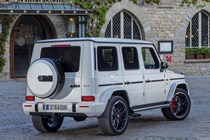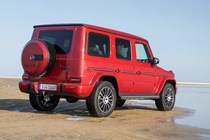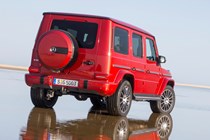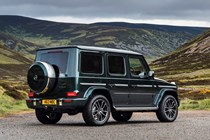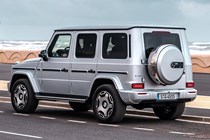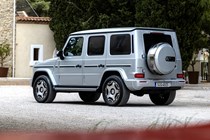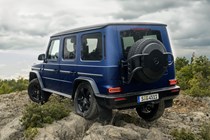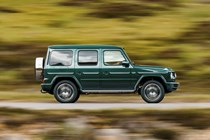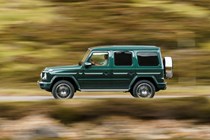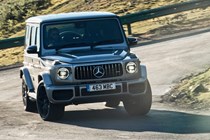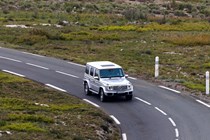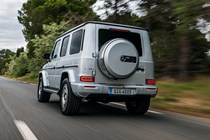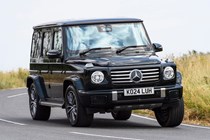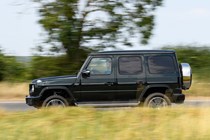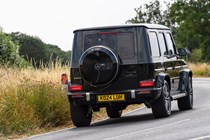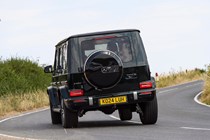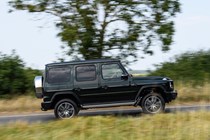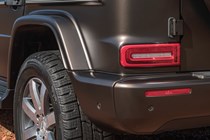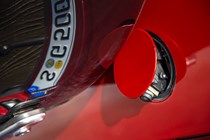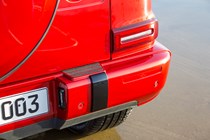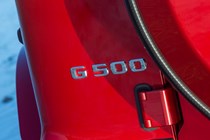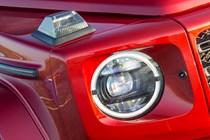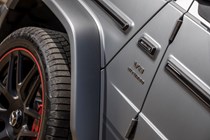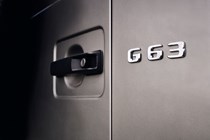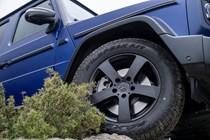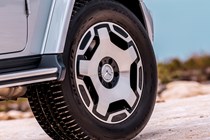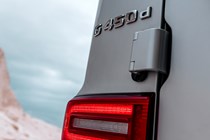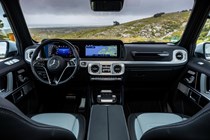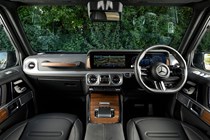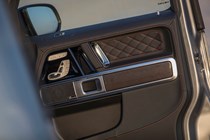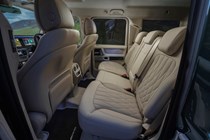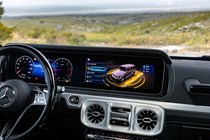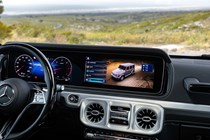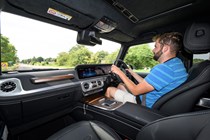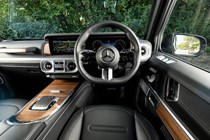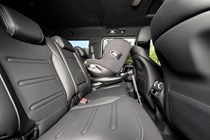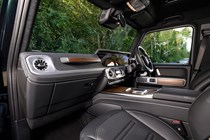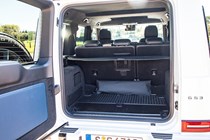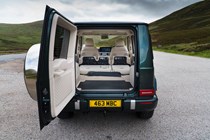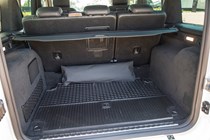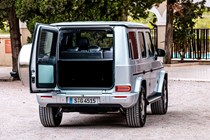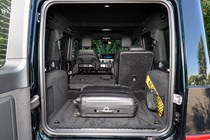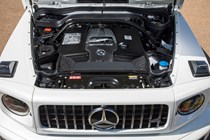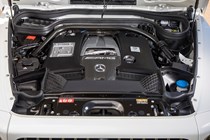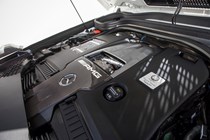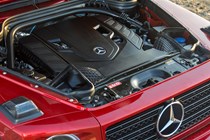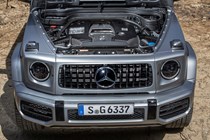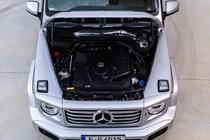
Mercedes-Benz G-Class boot space, practicality and safety
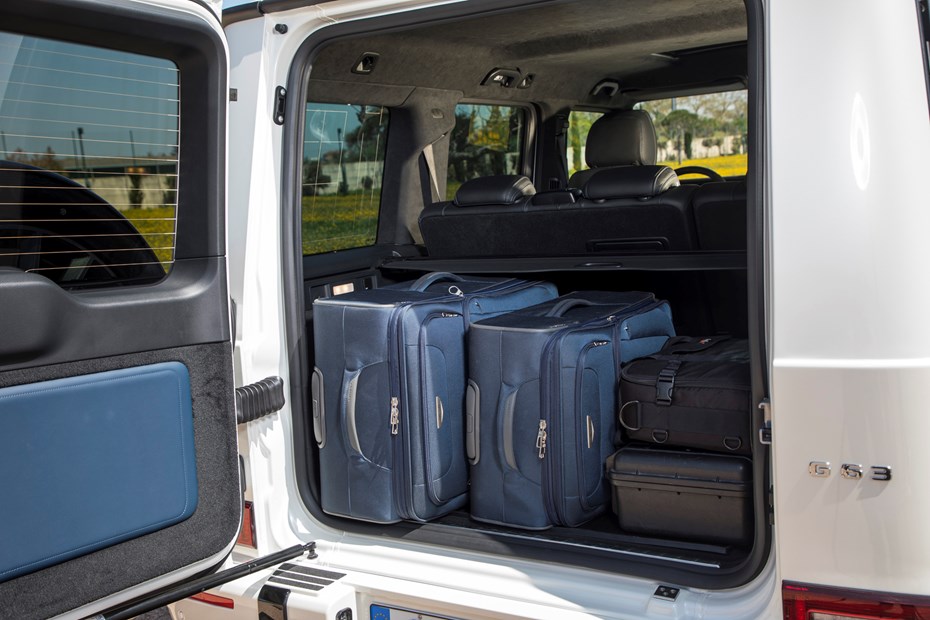
- Rear legroom tighter than you’d think
- Uneven extended load bay
- Standard 60/40 split rear seat
How much space is there?
The facelifted Mercedes-Benz G-Class remains as it was, which means it’s longer, wider and taller than its predecessor, and more than capable of accommodating your family and luggage. This is good news, as many luxury SUVs can be embarrassingly cramped compared with their estate or saloon counterparts.
Ample elbow room is especially noticeable up front, which combined with plentiful headroom, even with a sunroof fitted, and seats that go a long way back means even tall adults can stretch out.
Move to the rear and once again there’s almost excessive amounts of head room, although leg room is tighter than you might expect. A couple of tall adults up front limits the amount available for those in the back significantly, making a BMW X7, Range Rover or Defender 110 a better bet for carrying five tall adults.
Thanks to an unusually low transmission tunnel (another benefit of the ladder-frame chassis), you can realistically accommodate a fifth passenger in the rear middle seat in comfort. Still, the Defender and Range Rover are similarly good here. Unlike the X7 and Defender, no seven-seat option is offered.
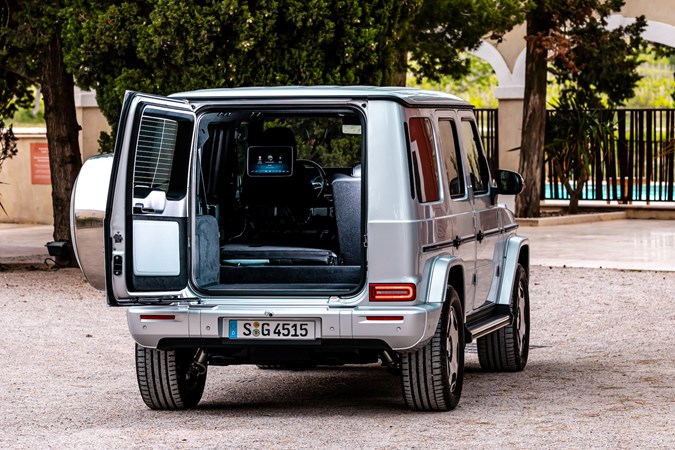
Boot space and storage
Like on the Land Rover Defender or Toyota Land Cruiser, the Mercedes-Benz G-Class’s tailgate has always been side-hinged. This can make opening the boot a little tricky, particularly in the UK as it’s hinged on the left – and the door is very heavy because of the spare wheel. Thankfully, the gas strut is now intelligent enough to lock the tailgate in place no matter how open it is.
Once open, the boot size itself looks a little disappointing at first glance. What look like wide wheelarches pinch the loadbay noticeably on either side, leaving a narrow boot space for your bags or dog. In fact, the sub-woofer for the stereo is responsible for the intrusion on the left-hand side, while the right-hand lump gobbling up your luggage space is in fact the fuel tank.
What remains is a square-ish 454 litres – not much better than you’d get in a family hatchback (that figure swells to 667 litres if you pack to the roofline – or 1,941 with the seats folded). The rear seats do split in a 60:40 pattern, letting you carry longer loads and there’s a useful ski flap. Just be warned that the rear seats don’t fold entirely flat, leaving a sizable step in the extended load bay. Other handy touches include luggage tie down hooks and a small net to stop smaller items sliding about.
Storage solutions up front include some usefully big door pockets and a large cubby under the central armrest. There’s a couple of generously sized cupholders just beneath the clock and a little shelf for a smartphone, too. In other words, more than enough to empty your pockets.
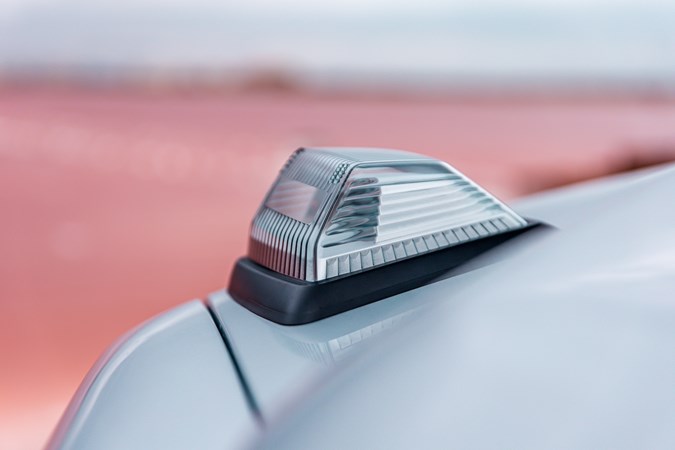
Is it easy to park?
There’s a huge benefit to the perpendicular, set-square styling here: the Mercedes-Benz G-Class is surprisingly easy to place on the road and park, as visibility is excellent.
Parking Assist is standard on this off-roader, helping manoeuvring with a range of ultrasonic sensors to provide sonar-like beeping while a 360-degree, panoramic reversing camera assists further. These are standard on all trims.
The improved steering set-up on the G-Class means it will also steer into a space automatically at your command, the wheel spinning eerily between your fingers. Even so, it is a big SUV so you’ll need to select your space carefully.
Safety
- Euro NCAP award the G-Class five stars
- There’s more safety kit on offer than before
- Two Isofix points in the back
The Mercedes-Benz G-Class remains a strong, robust car – qualities reinforced when it was awarded a five-star crash-test rating by Euro NCAP in 2019. Even so, there are plenty of newer rivals that do an even better job of guarding from injuries in a crash.
Automatic emergency braking is standard, as is lane keeping assistance and adaptive cruise control to make motorway work a little easier. You don’t get the semi-autonomous steering systems available in newer Mercedes models, though.
A pair of Isofix attachments on the two outer rear seats means you can easily attach a couple of child seats in the back of a G-Class. Big, wide-opening doors and the car’s unusual height ensure that fitting them is quite easy – it’s quite liberating not having to bend down to sort all the rigmarole of strapping your little ones into their car seats.
Watch Mercedes-Benz G-Class crash test video

Euro NCAP rating
| What is Euro NCAP? ⓘ | |
|---|---|
| Adult Occupant: | 90% |
| Child Occupant: | 83% |
| Vulnerable Road User: | 78% |
| Safety Assist: | 72% |
Equipment and options
- ABS
- Alarm
- Driver`s airbag
- Electric driver`s seat
- Electric mirrors
- Electric passenger`s seat
- Front electric windows
- Heated mirrors
- Heated seats
- Isofix child seat anchor points
- Parking sensors
- PAS
- Passenger`s airbag
- Rear electric windows
- Sat Nav
- Service indicator
- Side airbags
- Traction control
- 3x3 point rear seat belts
- Audio remote
- Cruise control
- Electric sunroof
- Full size spare wheel
- Leather seat trim
- Metallic Paint
- Remote locking
- Steering wheel rake adjustment
- Steering wheel reach adjustment
- n/a
- 3x3 point rear seat belts
- Audio remote
- Cruise control
- Leather seat trim
- Metallic Paint
- Remote locking
- Steering wheel rake adjustment
- Steering wheel reach adjustment
- Body coloured bumpers
- CD
- Climate control
- DVD
- Electric sunroof
- Full size spare wheel
- Height adjustable drivers seat
- Space saver spare wheel
- 3x3 point rear seat belts
- Audio remote
- Body coloured bumpers
- CD
- Climate control
- Cruise control
- DVD
- Electric sunroof
- Height adjustable drivers seat
- Leather seat trim
- Metallic Paint
- Remote locking
- Space saver spare wheel
- Steering wheel rake adjustment
- Steering wheel reach adjustment
- n/a
- 3x3 point rear seat belts
- Audio remote
- Body coloured bumpers
- CD
- Climate control
- Cruise control
- DVD
- Electric sunroof
- Full size spare wheel
- Height adjustable drivers seat
- Leather seat trim
- Metallic Paint
- Remote locking
- Space saver spare wheel
- Steering wheel rake adjustment
- Steering wheel reach adjustment
- n/a
- 3x3 point rear seat belts
- Audio remote
- Body coloured bumpers
- CD
- Climate control
- Cruise control
- DVD
- Height adjustable drivers seat
- Leather seat trim
- Metallic Paint
- Remote locking
- Space saver spare wheel
- Steering wheel rake adjustment
- Steering wheel reach adjustment
- n/a
- Audio remote
- Body coloured bumpers
- CD
- Climate control
- Cruise control
- DVD
- Electric sunroof
- Height adjustable drivers seat
- Leather seat trim
- Metallic Paint
- Remote locking
- Space saver spare wheel
- Steering wheel rake adjustment
- Steering wheel reach adjustment
- 3x3 point rear seat belts
- Full size spare wheel
- 3x3 point rear seat belts
- Electric sunroof
- Full size spare wheel
- Partial leather seat trim
- Audio remote
- Body coloured bumpers
- CD
- Climate control
- Cruise control
- DVD
- Height adjustable drivers seat
- Leather seat trim
- Metallic Paint
- Remote locking
- Space saver spare wheel
- Steering wheel rake adjustment
- Steering wheel reach adjustment
Dimensions
| Length | 4817mm - 4873mm |
|---|---|
| Width | 2187mm |
| Height | 1966mm - 1973mm |




